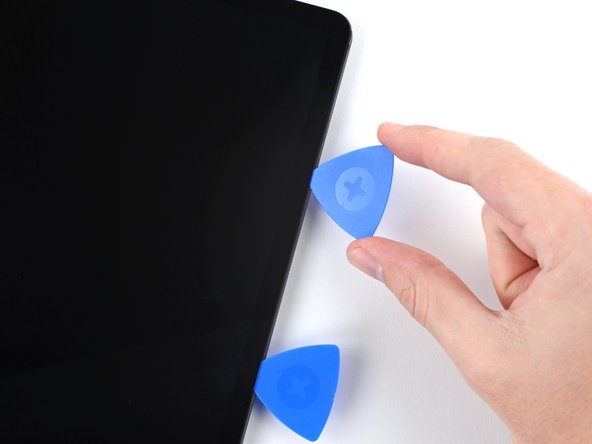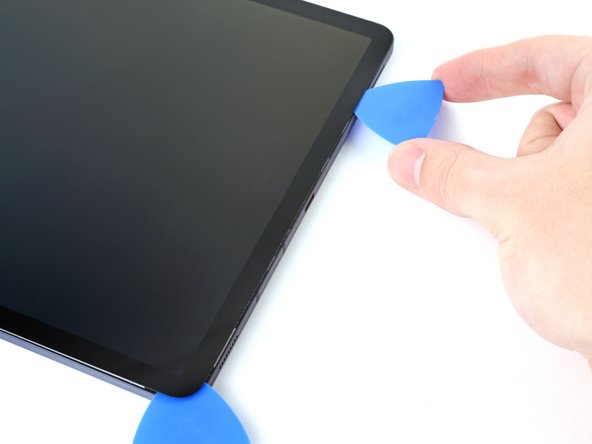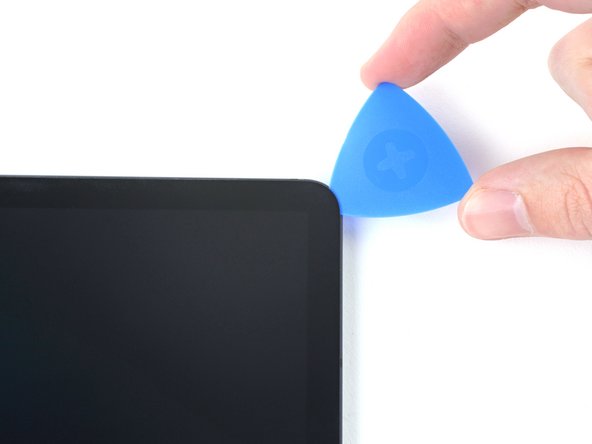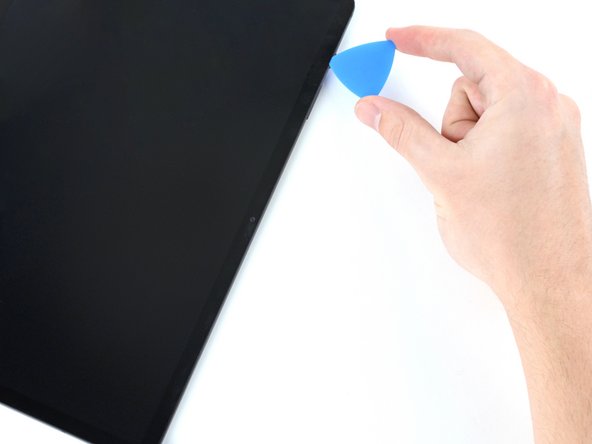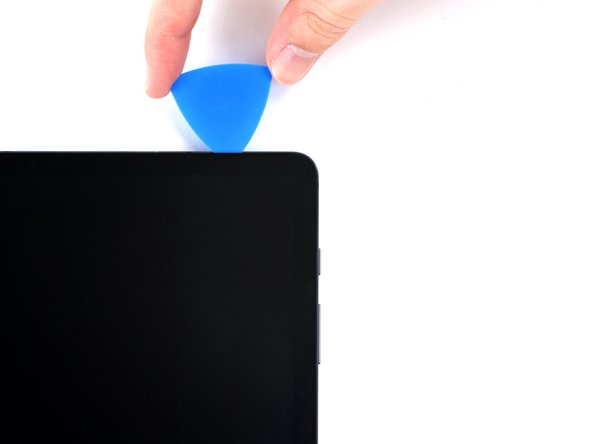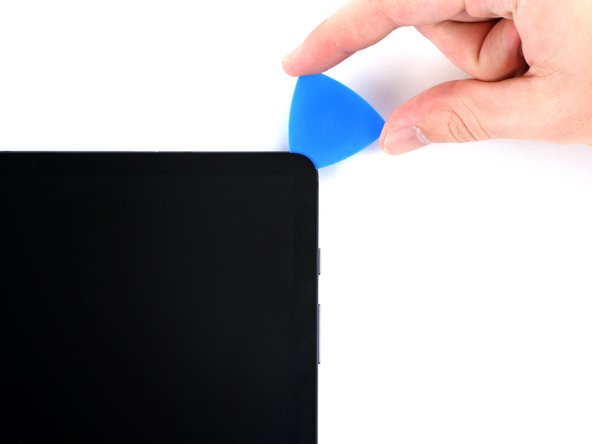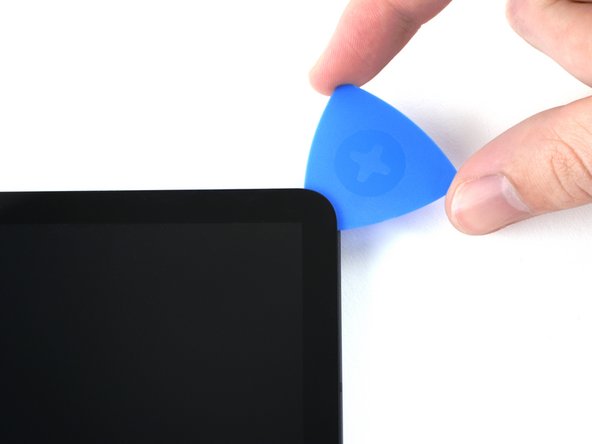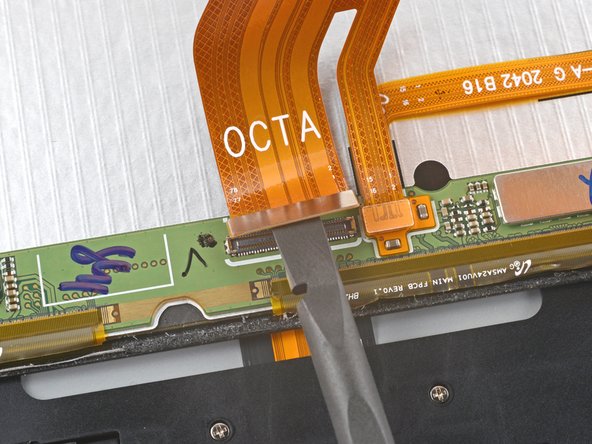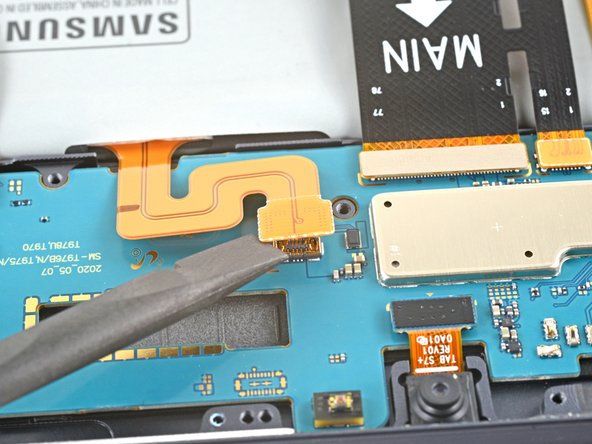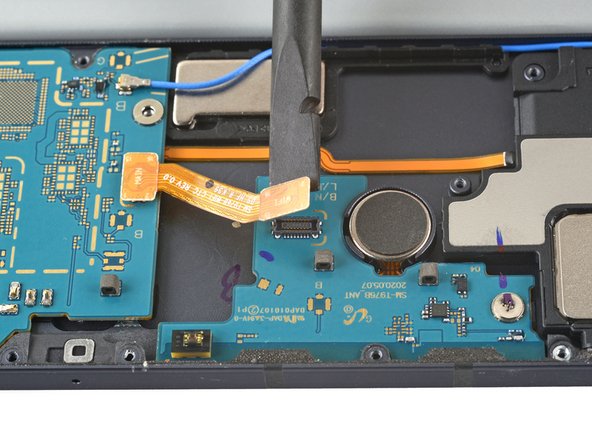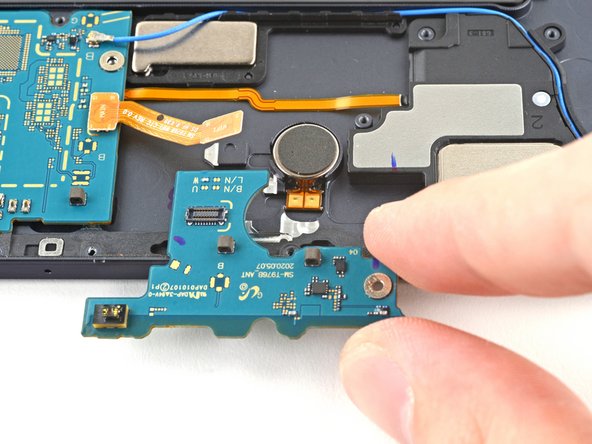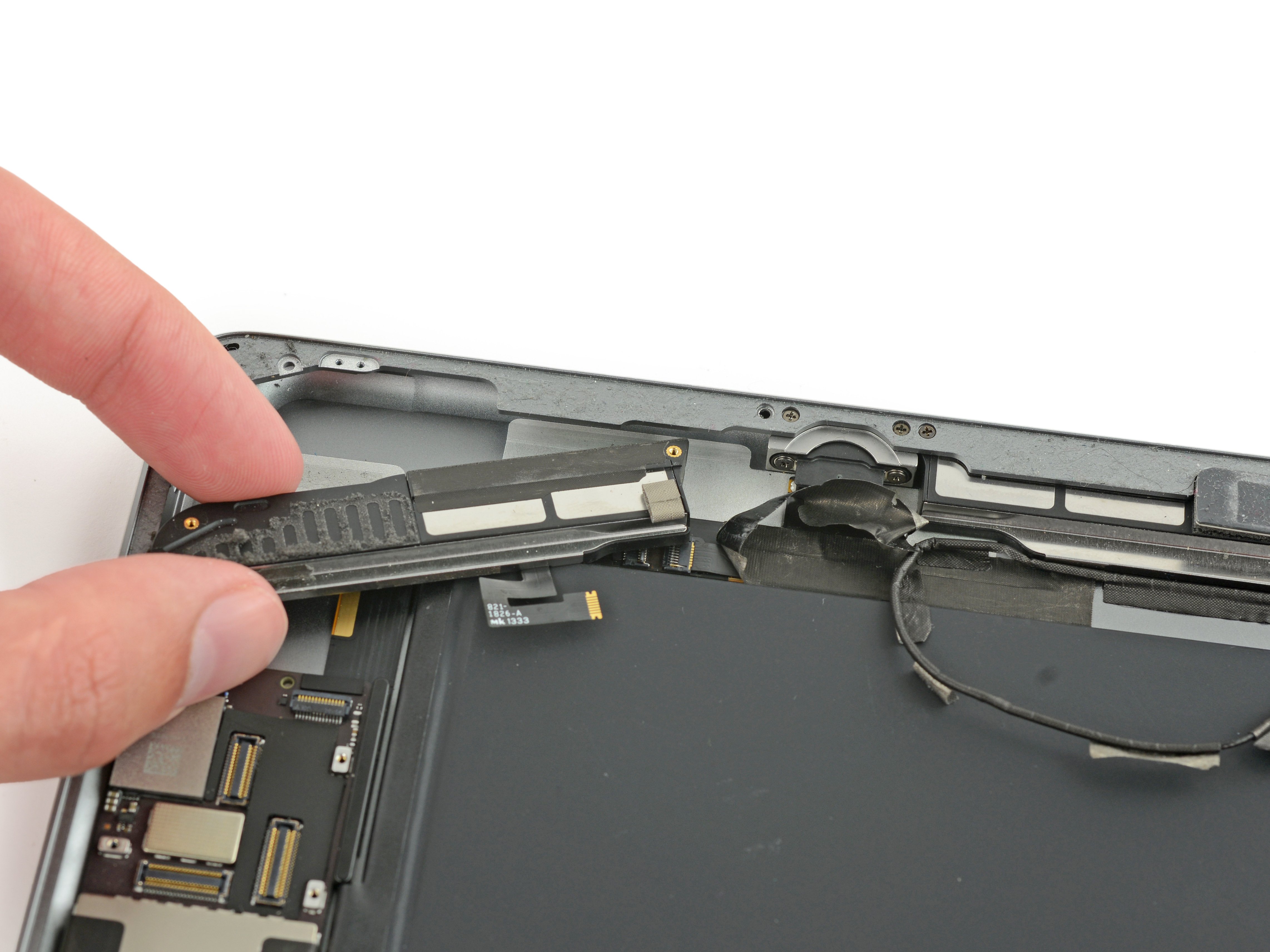Samsung Galaxy Tab S7 Plus Antenna Board Replacement
Duration: 45 minutes
Steps: 24 Steps
For your safety, make sure to drain the battery below 25% before you start disassembling your tablet. Also, watch out—there’s a good chance you’ll crack that delicate, unreinforced display panel during this process. If you need help, you can always schedule a repair.
Ready to swap out the antenna board on your Samsung Galaxy Tab S7+? Start by making sure your battery is below 25%—this helps keep things safe if the battery gets a little banged up while you’re working. If your battery looks puffy, go slow and take care. The screen is pretty delicate, so use lots of heat and take your time when prying it open. You’ll need fresh adhesive to put everything back together. If things get tricky, you can always schedule a repair.
Step 1
– Heat up that iOpener and give the bottom edge of your device some love to help loosen the sticky stuff underneath. You’ve got this!
Make sure to totally power down your device before diving in. Let’s keep things safe and sound!
The adhesive holding the Galaxy Tab S7+ display is super strong, so you’ll likely need to heat things up and reapply your iOpener a few times during the process—both before starting and throughout the display removal. You can also use a hair dryer, heat gun, or hot plate to warm things up, but just be cautious not to overheat your device. Taking your time with gentle heat will make the job smoother. If you need help, you can always schedule a repair.
Tools Used
Step 2
Keep the pick shallow—no deeper than 2 mm—to steer clear of the circuit board.
Keep the pick under 3 mm deep so the display stays happy and intact.
– While you’re waiting for the adhesive to loosen, here’s a quick heads-up:
– There’s a long circuit board snugly attached to the screen, running parallel to the bottom edge. Keep an eye on it!
– Check out this image showing the display beginning to separate from the glass panel. It’s a good visual of what you’re aiming for.
Step 3
– First things first, let’s warm up that screen until it’s cozy to the touch. Next, grab a suction handle and stick it onto the bottom edge of the screen, as close to the edge as you can get.
– Now, gently lift that screen with the suction handle to create a little gap between the screen and the frame. We’re making progress!
– Time to slide an opening pick into that gap between the frame and the screen. We’re almost there!
– Keep the opening pick in place to stop the adhesive from getting too friendly and resealing. You’ve got this!
Keep the pick to a maximum of 2 mm in to avoid any circuit board drama!
If your screen is heavily cracked, try covering it with a layer of clear packing tape to help the suction cup stick. If that doesn’t work, strong tape can be a good substitute for the suction handle. And if all else fails, you can superglue the suction cup directly onto the screen. Need extra help? You can always schedule a repair.
Tools Used
Step 4
– Pop a fresh opening pick into the gap you just made—nice work!
– Glide that new pick along the bottom edge, heading for the bottom-right corner.
Step 5
– Place a heated iOpener along the right edge of the device to soften the adhesive underneath. Keep the heat steady to make the adhesive more pliable. If you need help, you can always schedule a repair.
Tools Used
Step 6
– Swing that opening pick around the bottom-right corner—think of it as drawing a smooth arc.
– Keep the pick in place so the sticky stuff doesn’t try to make a comeback.
Step 7
Hey there! When you’re inserting the pick, keep it gentle—no more than 3 mm—to avoid any accidental damage to those delicate components on the right edge. Take it slow and steady, and if you need a hand, you can always schedule a repair.
– Insert a new opening pick into the gap you made. Then, glide the pick along the right edge of the device toward the top-right corner. If you need help, you can always schedule a repair.
Step 8
– Place a heated iOpener on the top edge of the device to soften the adhesive underneath. This will make it easier to lift the cover without any fuss. If you need help, you can always schedule a repair.
Tools Used
Step 9
– Gently rotate the opening pick around the top-right corner of the device, like you’re opening a treasure chest. Keep the pick in place afterward to stop the adhesive from sticking back together. If you need help, you can always schedule a repair.
Step 10
– Gently slide a fresh opening pick into the gap you just made.
– Carefully glide that pick along the top edge of the device, steering it towards the top-left corner.
Step 11
– Warm up the iOpener and give the left edge of your device some love. Let it work its magic and loosen up that adhesive underneath.
Tools Used
Step 12
– Gently twist the opening pick around the top-left corner of your device, like you’re giving it a little dance.
– Keep that opening pick snugly in place to stop the adhesive from trying to seal back up. You’ve got this!
Step 13
– Gently slide a fresh opening pick into the gap you’ve made.
– Move that pick along the left side of your device all the way down to the bottom-left corner.
Step 14
By now, the screen’s edges should be free from the frame. If the sides are still sticking, grab your opening pick and run it around the perimeter again to slice through that stubborn adhesive.
– Gently rotate your opening pick around the bottom-left corner of the device to loosen the adhesive.
– Keep the pick in place to stop the adhesive from sealing back up as you work.
Step 15
Hold up on trying to peel back the screen all the way—it’s still hanging on by that flex cable. And be gentle: don’t twist or yank the screen too far from the frame, or you might damage that delicate flex cable. Keep it cool, and if you need a hand, you can always schedule a repair.
– With the screen facing up and you in charge, gently lift it away from the device like you’re opening a book—just like that!
– Carefully flip the screen over and rest it, face down, so it’s parallel with the frame before moving on.
– Before you seal it all back up, take a moment to power on your tablet and make sure everything’s running smoothly. Once you’re happy with it, shut it down fully to continue.
– Got any leftover adhesive bits? Grab your tweezers or fingers and remove them. Use some high-concentration (90% or higher) isopropyl alcohol to clean off any sticky residue.
– If you’re using custom-cut adhesives, follow this guide. If double-sided tape is your thing, check out this guide for that.
Tools Used
Step 16
– Grab your trusty spudger and gently use its flat end to lift and disconnect the display cable’s press connector from the screen. Easy peasy!
– When it’s time to reattach those connectors, make sure to line them up just right and press down on one side until you hear that satisfying click. Then, do the same on the other side. Remember, no pressing down in the middle! If things get a bit off, the pins might bend, leading to some serious trouble. If you need help, you can always schedule a repair.
Tools Used
Step 17
– Grab some tweezers or your trusty fingers to keep that display cable nice and steady.
– With the flat end of a spudger, gently lift and disconnect the fingerprint sensor’s press connector from the display cable—easy peasy!
– Remember where that display cable was sitting; you’ll want to bend it just like that when you’re hooking up the new screen.
Step 18
– Gently lift the screen away from the frame, making sure to keep everything steady. If you need help, you can always schedule a repair.
Step 19
– Grab your Phillips #00 screwdriver and carefully remove the 50 screws, each 3mm long, holding the frame bracket in place.
– In the third photo, you’ll see the screws marked by quadrant. Keep it handy when putting everything back together to make sure no screw is left behind:
– Bottom left: 9 screws
– Bottom right: 14 screws
– Top right: 12 screws
– Top left: 15 screws
Tools Used
Step 20
– Gently lift the frame bracket off the frame, guiding the display cable right through its socket as you go.
Step 21
– Grab the flat end of your spudger and gently work it under the battery’s press connector to lift and disconnect it from the motherboard. A little finesse goes a long way here!
Tools Used
Step 22
– Grab the flat end of your spudger and gently pop up the press connector for the antenna board interconnect cable—it’s hanging out on the antenna board, so just give it a careful nudge!
Tools Used
Step 23
– Grab a Phillips 00 screwdriver and unscrew the small 2 mm screw holding the antenna board in place. If you need help, you can always schedule a repair.
Step 24
– Gently insert a spudger into the space between the antenna board and the frame.
– Carefully pry up with the spudger to lift the antenna board away from the frame.
– Lift out and remove the antenna board.
Tools Used
Success!










